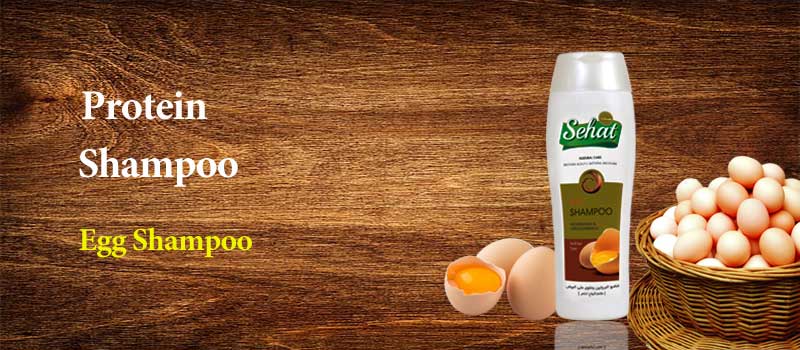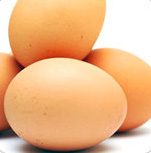
- Product Information
- Ingredients
- Secrets of Nature
Sehat Egg Shampoo contains egg extract and glycerin. With the essential fatty acids for new skin cell growth, it improves the function of skin cells, and makes hair soft and silky.
- A potent hair and scalp strengthener.
- Contains albumin that makes hair shiny and treats damaged hair
- Leaves a pleasant scent after washing
- With a pH-balanced formula
| Volume | Per carton |
| 300 ml | 24 |
| 1000 ml | 12 |
| Egg extract | Aqua & Dexpanthenol | Pearly Sodium Laureth Sulfate |
| Cocamidopropyl betaine | Coconut fatty Acid DEA | Glycerin |
| Sodium chloride | Citric acid | |
| Propylene Glycol | EDTA & Vitamin E | شامپو سدر صحتh |
| Ingredients | ||

Egg
Constituents and Characteristics:
Chicken eggs are a good source of proteins, vitamins and vital minerals and can be an effective way of delivering a range of important nutrients into the human diet.
Nutritional Value
A medium egg contains 76 Kcal of energy. Eating one egg every day provides three percent of the energy an adult man needs each day and four percent of the energy of an adult woman.
Protein
Egg is a rich source of protein. Its biological value is extremely large and is richer than other sources of protein such as dairy products, various meats and cereals. The egg's protein supplies all essential amino acids for humans. Therefore, intake of egg with other foodstuffs that are poor sources of protein such as bread, rice and grains improves the protein value of food.
The protein in eggs has a biological quality greater than any other natural food. Eggs are given a protein rating of 100 and are used as a standard for measuring the protein quality of other foods.
Vitamins
Egg contains almost all essential vitamins for human body except vitamin C. It is also a good source of vitamins A and B, and contains relatively less amount of vitamins D and E.
Minerals
Egg contains all essential minerals needed for health. Egg is also is a good source of iodine and phosphorus. Iodine is an important component in the synthesis of thyroid hormones. Phosphorus is also necessary for the formation of bones.
Other minerals in egg are zinc, selenium, iron, calcium. Zinc is effective in fighting infections and vital in activating growth - height, weight and bone development - in infants, children and teenagers.
Iron is an important component of red blood cells. Also, calcium plays a dominant role in functioning of the nervous system, and helps bones grow stronger.
Fat
About 10.8% the egg content is fat. The fat of an egg is found almost entirely in the yolk; there is less than 0.05% in the albumen. Approximately 17% of an egg’s fatty acids are polyunsaturated, 44% monounsaturated and only 32% saturated.
Cholesterol
Eggs also contain cholesterol and lecithin, which are fat-like substances that are essential to the structure and function of all cells in the body. However these substances are not dietary essentials, as our bodies are able to synthesize them. Cholesterol helps to maintain the flexibility and permeability of cell membranes and is also a raw material for the fatty lubricants that help to keep the skin supple. Cholesterol is essential for the production of sex hormones, cortisol, vitamin D and bile salts.
In the past it was thought that people should limit the number of eggs they eat because they contain dietary cholesterol, but recommendations on limiting egg consumption have now been relaxed by heart and health advisory groups in both the US and UK, including the British Heart Foundation and the Food Standards Agency.
Over 30 years of prospective epidemiological surveys of CHD risk have consistently found no independent relationship between dietary cholesterol or egg consumption and CHD risk. In addition, there is strong evidence showing that the effects of cholesterol-rich foods on blood cholesterol are small and clinically insignificant in comparison with the effects of dietary saturated fatty acids (SFA). SFA influence the level of circulating low density lipoprotein (LDL)-cholesterol to a much greater extent than dietary cholesterol in foods such as eggs.
This evidence has led to major world and UK health organizations revising their guidance3, including the British Heart Foundation which has dispensed with its recommendation limiting eggs to 3-4 a week, although people with familial hypercholesterolemia (1 in 500 in the UK) would still be advised to restrict dietary cholesterol intake. The Food Standards Agency also advises that most people don’t need to limit how many eggs they have, if they are eating a balanced diet. The American Heart Association has also removed specific reference to eggs in their dietary recommendations for heart health.
Constituents of Egg
Constituents of an egg are the shell (9-12%), white (60-63%) and yolk (30-33%).
The egg consists of 65% water, 11.8% protein, 11% lipid and 11.7% ash.
- Shell
- Bumpy and grainy in texture, the shell is made of calcite, a crystalline form of calcium carbonate. It is a semi permeable membrane, which means that air and moisture can pass through its pores. The shell also has a thin outermost coating called the bloom or cuticle that helps keep out bacteria and dust.
- The shell is approximately 9-12 percent of the total egg's weight. It is the first defense against bacteria invasion. Do not wash the egg unless you want to eat it. Because the outer coat is water soluble and is removed easily by washing and will fall into a state of decay.
- The eggs should be kept in closed case, since the odor and taste of other foods can seep into the eggshell.
- The shell consists of 94% calcium carbonate, 1% calcium phosphate, 4% minerals and vitamin D.
- The variation in eggshell is caused by pigment deposition during egg formation in the oviduct and can vary according to species and breed, from white to dark brown. White and brown eggs have no difference in biological value or taste.
- Inner and Outer Membranes
- Inner and outer shell membranes are relatively thin keratin-like membranes and one of the egg's chief defenses against bacterial invasion. The inner membrane is thinner than the outer membrane.
- Air Cell
- The larger end of the egg contains the air cell that forms when the contents of the egg cool down and contract after it is laid. Chicken eggs are graded according to the size of this air cell, measured during candling. A very fresh egg has a small air cell and receives a grade of AA. As the size of the air cell increases, and the quality of the egg decreases, the grade moves from AA to A to B. This provides a way of testing the age of an egg: as the air cell increases in size, the egg becomes less dense and the larger end of the egg will rise to increasingly shallower depths when the egg is placed in a bowl of water. A very old egg will actually float in the water and should not be eaten.
- White (Albumen)
- The egg white is approximately two-thirds of the total egg's weight out of its shell with nearly 90% of that weight coming from water. The remaining weight of the egg white comes from protein, trace minerals, fatty material, vitamins, and glucose.
- The pH of an early egg white is 7.9 and rises over time that is caused by the amount of carbon dioxide lost from the egg. The darkness is albumin is related to freshness of the egg. It is because of the existence of carbon dioxide in the egg white. Its primary natural purpose is to protect the egg yolk and provide additional nutrition for the growth of the embryo.
- The egg white consists of 90% water, 10% protein, 1% carbohydrate, 0.5% ash and a negligible amount of fat.
- Riboflavin, niacin, potassium, sodium, sulfur, magnesium and chlorine are also found in the egg white.
- The proteins in the egg white include v-albumin (54%), conallbumin(12%), ovamucoid (12%), ovomucin, lysozyme, avidin, ovoglobulin, and flavor proteins.
- Yolk
- The yolk makes up about 33% of the liquid weight of the egg out of its shell. 50 percent of the egg's protein is in the yolk. The yolk serves as the food source for the developing embryo.
- The egg yolk consists of 50% water, 17% protein (phosphoproteins and lipoproteins), and 32% lipid (lecithin phospholipids (25%), triglycerides (75%), cholesterol).
- Egg yolk contains iron, calcium, phosphorus, zinc, iodine, copper, manganese, fat soluble vitamins (A, D, E and K), vitamins B7 (vitamin H, or biotin), kolin, B9 (folic acid), B5 (pantothenic acid), B8 (inositol, now not considered a vitamin), B6 (pyridoxine) and B12. Fat soluble vitamins can be found only in the yolk.
- All cholesterols and fats are in the yolk. The egg white does not have cholesterol and fat. The egg yolk contains less water and more vitamins, compared with the egg white. The biological value of egg yolk is higher than the egg white. Only the yolk contains zinc. Instead, salt is mainly in the egg white.
- The coating around the egg yolk is called vitelline, which covers the yolk and prevents it from spreading. Vitelline becomes fragile over time, and when the egg is broken, it loses its strong circular shape and spreads in the plate. The pH of egg yolk is always
- The yellow yolk
- The yellow yolk contains layers of alternate light and deep yellow yolk that cannot be seen by the naked eye. An egg yolk contains 25 KJ of energy. A large egg contains 213 mg of cholesterol. The allowed cholesterol intake is less than 300 mg per day for a healthy person, and 200 mg per day for people with heart disease or high blood pressure.
- The pigments of egg yolk are caused by the existence of xanthophylls lutein and zeaxanthin.
- Sometimes, boiled eggs have a dark green discolored coating around the yolk. The discoloration is due to the formation of ferrous sulfide where the yolk and white meet. It is formed when iron from the yolk reacts with hydrogen sulfide from the white. Discolored egg yolks are harmless. However, pouring cold water over the eggs after they are done and not overcooking will prevent this discoloration.
- Blood or meat spots are occasionally found on an egg yolk and are merely an error on the part of the hen. They are caused by the rupture of a blood vessel on the yolk surface when it is being formed or by a similar accident in the wall of the oviduct. Both chemically and nutritionally, eggs with blood spots are fit to eat. You can remove the spot with the tip of a knife. Blood spots occur only in one percent of eggs.






















